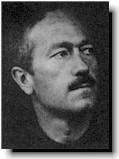

![]() Anthony
Colin Bruce Chapman was born on 9 May, 1928 in a suburb of London. He grew up
living at the Railway Hotel, Hornsey, which his father managed. One of the first
significant events of Chapman's life occurred in March of 1944 when he met his
future wife, Hazel Williams, at a dance. Even prior to their marriage ten years
later she was to be instrumental in helping Chapman make a name for himself in
racing and car building, among other things putting up the initial 25 pounds
sterling to get Lotus Engineering Co., Ltd., started in 1952.
Anthony
Colin Bruce Chapman was born on 9 May, 1928 in a suburb of London. He grew up
living at the Railway Hotel, Hornsey, which his father managed. One of the first
significant events of Chapman's life occurred in March of 1944 when he met his
future wife, Hazel Williams, at a dance. Even prior to their marriage ten years
later she was to be instrumental in helping Chapman make a name for himself in
racing and car building, among other things putting up the initial 25 pounds
sterling to get Lotus Engineering Co., Ltd., started in 1952.
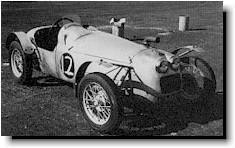 Chapman
seems to have been taken by fast machinery from an early age. He learned to fly
at university, and, after earning a degree in civil engineering in 1948, he was
for a short time a flying officer with the RAF. Aviation was to remain a
lifelong passion. When he got into car building he soon began to compete. He
became determined to achieve great things as a driver. His approach to covering
the financial requirements was to build a car for himself, demonstrate its
qualities on the course, and then sell his innovations and services, and later
copies (not always exact) of the cars themselves, to other enthusiasts in
post-war England. The very first one-off he built was a modification of a 1930
Austin Seven saloon, and it was only as an afterthought that he decided to enter
it in trials races. He had never even been to a motor race before. From there he
was off on a tenacious hunt for loopholes in regulations that would give him an
edge. Many of these were of the very small variety, and allowed him to exercise
and hone his novel engineering approach to the maximum.
Chapman
seems to have been taken by fast machinery from an early age. He learned to fly
at university, and, after earning a degree in civil engineering in 1948, he was
for a short time a flying officer with the RAF. Aviation was to remain a
lifelong passion. When he got into car building he soon began to compete. He
became determined to achieve great things as a driver. His approach to covering
the financial requirements was to build a car for himself, demonstrate its
qualities on the course, and then sell his innovations and services, and later
copies (not always exact) of the cars themselves, to other enthusiasts in
post-war England. The very first one-off he built was a modification of a 1930
Austin Seven saloon, and it was only as an afterthought that he decided to enter
it in trials races. He had never even been to a motor race before. From there he
was off on a tenacious hunt for loopholes in regulations that would give him an
edge. Many of these were of the very small variety, and allowed him to exercise
and hone his novel engineering approach to the maximum.
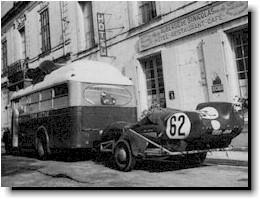 Early
on he held a position with The British Aluminium Company and relied on long
hours, volunteer help and barter arrangements (in consideration for assistance
he gave to BRM with their F1 suspension design he received a converted Ford
Zephyr) to keep his car building operation afloat. It was tough going even after
Lotus cars became well known as winners. Chapman branched out from trials
machines to sports cars achieving success at that level as well. At the end of
1954 he was able to quit his day job and devote himself entirely to Lotus
Engineering and Team Lotus, the newly-formed competition arm of the business. He
was also able to take on paid employees, among whom were names such as Mike
Costin, Keith Duckworth and Graham Hill. Lotus Engineering built both road and
competition sports cars for customers, and eventually Formula 2 and, in 1958,
Formula 1 cars as well. Although single-seaters originally gave Lotus fits due
to their having to adapt their fragile chassis to very high power to weight
ratios, Team Lotus continued its on-track success in sports cars as Chapman
continued to develop his engineering magic.
Early
on he held a position with The British Aluminium Company and relied on long
hours, volunteer help and barter arrangements (in consideration for assistance
he gave to BRM with their F1 suspension design he received a converted Ford
Zephyr) to keep his car building operation afloat. It was tough going even after
Lotus cars became well known as winners. Chapman branched out from trials
machines to sports cars achieving success at that level as well. At the end of
1954 he was able to quit his day job and devote himself entirely to Lotus
Engineering and Team Lotus, the newly-formed competition arm of the business. He
was also able to take on paid employees, among whom were names such as Mike
Costin, Keith Duckworth and Graham Hill. Lotus Engineering built both road and
competition sports cars for customers, and eventually Formula 2 and, in 1958,
Formula 1 cars as well. Although single-seaters originally gave Lotus fits due
to their having to adapt their fragile chassis to very high power to weight
ratios, Team Lotus continued its on-track success in sports cars as Chapman
continued to develop his engineering magic.
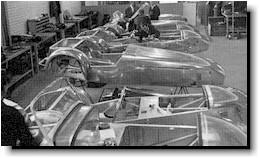 Lotus
cars, though intentionally built sparingly, were not gimcracks. Chapman, above
all, wanted his cars to win. Their notorious frailty was no accident. Chapman
was unswerving in his devotion to minimalist design philosophy. Each part had to
do as many jobs as it was possible to squeeze out of it. Although this trade-off
was not always adequate, when it did pay off it was dynamite.
Lotus
cars, though intentionally built sparingly, were not gimcracks. Chapman, above
all, wanted his cars to win. Their notorious frailty was no accident. Chapman
was unswerving in his devotion to minimalist design philosophy. Each part had to
do as many jobs as it was possible to squeeze out of it. Although this trade-off
was not always adequate, when it did pay off it was dynamite.
Chapman's motivation for this approach was apparently not parsimony, but something more deeply-seated in his personality. It is tempting to relate it to his tendency to treat superficially many of the people he had dealings with, but more likely it was just a manifestation of his extraordinary talents. What Chapman left out in material substance he replaced with cleverness. It was as if automobiles were to him ephemeral things, spirits of his own creation, or rather spirits formed by the act of their creation. Their physical existence seemed to have little importance. Only their performance was meaningful. It took great urging from friends and family before, late in life, he would make even belated efforts to preserve examples of some of his historically significant machines.
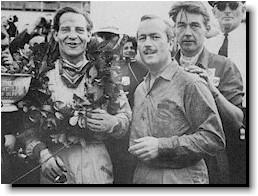 Although
his early cars were based on the space frame chassis (done up, as usual, better
than the original), the chassis development that he is most famous for was the
full monocoque that made its debut in the Lotus 25. The 25 was the first of
Chapman's F1 world-beaters and carried Jim Clark to his 1963 championship. It
was to be followed in due course by, among others, the 49, the 72 and the 79.
The 49, a winner its first time out, popularized the engine as a stressed
chassis member, and was Chapman's masterpiece and the epitome of his insistence
on extreme economy of design; the 72 sported novel features such as a wedge
shape, torsion bar springing and inboard brakes; and the 79 was the pinnacle of
ground effects, an ingenious madness of which Chapman was, again, a major
innovator. He did not, of course, conceive all of these cars by himself. Others
including Duckworth and Maurice Phillippe made indispensable contributions.
Chapman, in the best engineering tradition, was quick to borrow ideas from other
sources including the aerospace industry. But his finger prints were all over
the design and engineering of every Lotus while he was alive. As a matter of
fact, news of Chapman's untimely death was brought to Team Lotus while they were
breaking in the 92 with its active suspension, the master's last great technical
revolution.
Although
his early cars were based on the space frame chassis (done up, as usual, better
than the original), the chassis development that he is most famous for was the
full monocoque that made its debut in the Lotus 25. The 25 was the first of
Chapman's F1 world-beaters and carried Jim Clark to his 1963 championship. It
was to be followed in due course by, among others, the 49, the 72 and the 79.
The 49, a winner its first time out, popularized the engine as a stressed
chassis member, and was Chapman's masterpiece and the epitome of his insistence
on extreme economy of design; the 72 sported novel features such as a wedge
shape, torsion bar springing and inboard brakes; and the 79 was the pinnacle of
ground effects, an ingenious madness of which Chapman was, again, a major
innovator. He did not, of course, conceive all of these cars by himself. Others
including Duckworth and Maurice Phillippe made indispensable contributions.
Chapman, in the best engineering tradition, was quick to borrow ideas from other
sources including the aerospace industry. But his finger prints were all over
the design and engineering of every Lotus while he was alive. As a matter of
fact, news of Chapman's untimely death was brought to Team Lotus while they were
breaking in the 92 with its active suspension, the master's last great technical
revolution.
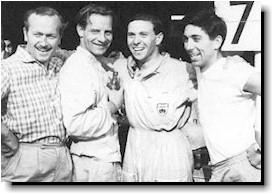 Colin
Chapman's story remains half told until Jim Clark is brought into it. Several
Lotus drivers won races only because they were in a Chapman car. But many
Lotuses won races only because Clark was driving them. Chapman and Clark were an
odd couple to say the least - Chapman the brilliant and charming engineer cum
salesman; Clark the reserved, thoughtful farmer from the Scottish Border
country, and the driver that Chapman at one time had wished to be. That they
were close nonetheless was due almost certainly to the fact that each recognized
the talents of the other in his particular sphere of motor racing, an enterprise
they both loved. Both were known for parting with a pound reluctantly, although
Chapman was significantly more sophisticated in money matters than was Clark,
perhaps, as it turned out, too sophisticated for his own good (he even managed
eventually to get Clark to pay his expenses from his Indianapolis expeditions
out of his retainers). Chapman showed no prescience in signing up Clark since by
that time the Scotsman's abilities were becoming general knowledge. He got Clark
and hung on to him because he built winning cars. The fruitful relationship
between the two, probably approached only by that between Tyrrell and Stewart,
was as much a result of each adapting to the other's natural shortcomings as
anything else. Clark was too down-to-earth to be shined up by Chapman's hard
sell, and Chapman was too savvy to be over awed by the driving ability of which
Clark was justifiably, and obviously, proud. Chapman was genuinely devastated by
Clark's death in 1968 in a Lotus 48 F2 car.
Colin
Chapman's story remains half told until Jim Clark is brought into it. Several
Lotus drivers won races only because they were in a Chapman car. But many
Lotuses won races only because Clark was driving them. Chapman and Clark were an
odd couple to say the least - Chapman the brilliant and charming engineer cum
salesman; Clark the reserved, thoughtful farmer from the Scottish Border
country, and the driver that Chapman at one time had wished to be. That they
were close nonetheless was due almost certainly to the fact that each recognized
the talents of the other in his particular sphere of motor racing, an enterprise
they both loved. Both were known for parting with a pound reluctantly, although
Chapman was significantly more sophisticated in money matters than was Clark,
perhaps, as it turned out, too sophisticated for his own good (he even managed
eventually to get Clark to pay his expenses from his Indianapolis expeditions
out of his retainers). Chapman showed no prescience in signing up Clark since by
that time the Scotsman's abilities were becoming general knowledge. He got Clark
and hung on to him because he built winning cars. The fruitful relationship
between the two, probably approached only by that between Tyrrell and Stewart,
was as much a result of each adapting to the other's natural shortcomings as
anything else. Clark was too down-to-earth to be shined up by Chapman's hard
sell, and Chapman was too savvy to be over awed by the driving ability of which
Clark was justifiably, and obviously, proud. Chapman was genuinely devastated by
Clark's death in 1968 in a Lotus 48 F2 car.
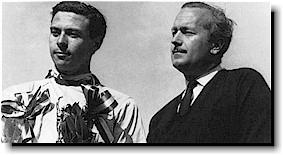 Chapman
was always considered a hardware person and not a people person. Yet some of the
greatest names in racing won for him, including Clark, Hill, Rindt, Peterson,
Andretti, Mansell and Fittipaldi. Stirling Moss, racing for privateer Rob
Walker, gave a Lotus car its first F1 victory. After Chapman's death, but while
vestiges of his influence still remained with the team, Senna chalked up
victories in Lotuses. Great drivers are seldom found consorting with mediocre
cars. The caliber of men who chose to drive Lotuses probably comprises the best
witness to the high quality of racing machines that Chapman produced.
Chapman
was always considered a hardware person and not a people person. Yet some of the
greatest names in racing won for him, including Clark, Hill, Rindt, Peterson,
Andretti, Mansell and Fittipaldi. Stirling Moss, racing for privateer Rob
Walker, gave a Lotus car its first F1 victory. After Chapman's death, but while
vestiges of his influence still remained with the team, Senna chalked up
victories in Lotuses. Great drivers are seldom found consorting with mediocre
cars. The caliber of men who chose to drive Lotuses probably comprises the best
witness to the high quality of racing machines that Chapman produced.
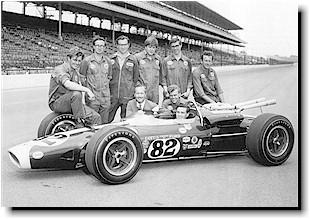 Chapman
achieved his greatest fame in the U.S. by forcing the rear-engined concept on
the technologically stagnant Indianapolis 500. Dan Gurney was the one who, after
seeing the Lotus 25, persuaded Chapman that Indy would be worth a look. That
look revealed, to Chapman's glee, an obscene amount of money that, considering
the competition, looked ripe for picking. Gurney set up a deal between Ford and
Chapman, and Clark did indeed nearly take the prize on the first try in 1963 in
a controversial finish. The Lotus-Ford missed again in 1964, but by its 1965
victory the majority of the cars in the field were rear-engined. There was no
great pioneering in the first Lotus Indy cars, not even the engine placement
since Brabham had been there and done that. The Lotus 29's combination of many
25 features plus a solid big block Ford engine was so far ahead of the
traditional roadsters that it made the whole thing akin to shooting fish in a
barrel. Lotus did break new ground in 1968 with a turbine powered car. It showed
such promise in that race that turbine cars were promptly banned by USAC.
Chapman
achieved his greatest fame in the U.S. by forcing the rear-engined concept on
the technologically stagnant Indianapolis 500. Dan Gurney was the one who, after
seeing the Lotus 25, persuaded Chapman that Indy would be worth a look. That
look revealed, to Chapman's glee, an obscene amount of money that, considering
the competition, looked ripe for picking. Gurney set up a deal between Ford and
Chapman, and Clark did indeed nearly take the prize on the first try in 1963 in
a controversial finish. The Lotus-Ford missed again in 1964, but by its 1965
victory the majority of the cars in the field were rear-engined. There was no
great pioneering in the first Lotus Indy cars, not even the engine placement
since Brabham had been there and done that. The Lotus 29's combination of many
25 features plus a solid big block Ford engine was so far ahead of the
traditional roadsters that it made the whole thing akin to shooting fish in a
barrel. Lotus did break new ground in 1968 with a turbine powered car. It showed
such promise in that race that turbine cars were promptly banned by USAC.
Not everything that Chapman touched turned to into technological gold. The Indy turbine cars had used four-wheel drive, and Chapman decreed that in 1969 so would the conventionally-powered Indy and F1 Lotuses. Alas this did not turn out well. The power train was cumbersome, the drivers complained about the common drive shaft passing through the cockpit over the top of their legs, and the cars were slow. They never competed.
It is difficult to overstate the influence, in so many different ways, that Chapman had on F1 as we know it today, what might be called "Big Formula 1." At the end of 1967 Esso pulled its support for motor racing. The CSI, which at the time oversaw the sporting aspects of the FIA, recognizing the need for expanded financial opportunities for an expanding F1, withdrew the restriction on advertisements on racing cars. Chapman was characteristically first in exploiting this opportunity, signing up Imperial Tobacco as the Team Lotus sponsor for 1968, in the process setting F1 on the road to a financial addiction to tobacco which has proved as difficult to shake as the real thing. English racing green gave way to Gold Leaf livery, and later to the stunning black and gold of the John Player Specials. There can be no argument about the monetary advantages that motor racing realized from tobacco sponsorship. It was inevitable that so much money floating around would attract attention, but curiously it was not Chapman but Lotus driver Jochen Rindt's former manager, Bernie Ecclestone, via his Formula One Constructors Association, who got control of it.
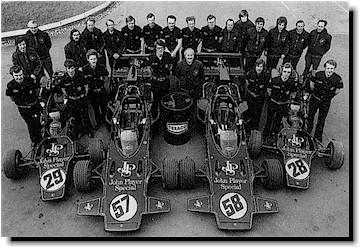 Chapman
did have a shot at running the money part of the F1 circus. During the great
FISA-FOCA war of 1979 - 1981 a conspiracy was hatched by Jean-Marie Balestre to
have Chapman replace Bernie Ecclestone as head of FOCA. It came to naught, but
one both delights and shudders at the thought of what F1 might be today had this
coup d'etat been carried off.
Chapman
did have a shot at running the money part of the F1 circus. During the great
FISA-FOCA war of 1979 - 1981 a conspiracy was hatched by Jean-Marie Balestre to
have Chapman replace Bernie Ecclestone as head of FOCA. It came to naught, but
one both delights and shudders at the thought of what F1 might be today had this
coup d'etat been carried off.
One of the casualties of the 1979-1981 unrest in the F1 world was another Chapman engineering marvel. In order to reduce chassis movement the suspensions of ground effects cars were so stiff that they were physically very hard on the driver. Enter the Lotus 86 and 88 incorporating aerodynamics and body work sprung separately from the cockpit. The 86 fell victim to the concession FOCA made in its truce with Balestre that did away with ground effects skirts. The 88 was ganged-up on and eliminated by assorted constructors and race organizers watching out for their wallets. Thereafter, ground effects itself was gradually all but legislated away. These triumphs of politics over progress was disheartening to Chapman for whom F1 had always been synonymous with the highest level of technical achievement. He seemed to lose much of his interest in the sport.
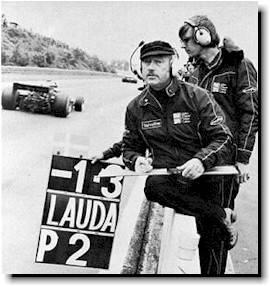 Towards
the end of his life Chapman, never one to shy away from a chance to make some
money, became entangled in the John DeLorean scandal. The British government
welcomed the DeLorean - Chapman partnership with open arms when it offered to
site the factory for DeLorean's stainless steel wonder car in depressed Belfast,
to the extent of putting up 54 million pounds of financing. Unfortunately
several million pounds of this never made it to Northern Ireland. Rumor had it
that its ultimate destinations were the pockets of DeLorean, Chapman and others.
DeLorean's arrest for allegedly dealing in a controlled substance and the
simultaneous collapse of the DeLorean car business left behind a nasty mess
indeed. Due to his premature passing, Chapman's real part in this sad affair has
never been completely explained.
Towards
the end of his life Chapman, never one to shy away from a chance to make some
money, became entangled in the John DeLorean scandal. The British government
welcomed the DeLorean - Chapman partnership with open arms when it offered to
site the factory for DeLorean's stainless steel wonder car in depressed Belfast,
to the extent of putting up 54 million pounds of financing. Unfortunately
several million pounds of this never made it to Northern Ireland. Rumor had it
that its ultimate destinations were the pockets of DeLorean, Chapman and others.
DeLorean's arrest for allegedly dealing in a controlled substance and the
simultaneous collapse of the DeLorean car business left behind a nasty mess
indeed. Due to his premature passing, Chapman's real part in this sad affair has
never been completely explained.
Chapman tossed his cap in the air in celebration of an F1 victory for the last time at the Austrian race in 1982, which Elio De Angelis took in a squeaker from Keke Rosberg. Chapman's death from a heart attack in December of that year was shockingly sudden and a surprise to everyone who had followed his unparalleled career. Some of these were legal authorities looking into the DeLorean fiasco, but the great majority were friends and family of motor racing who knew they had lost an irreplaceable part of their sport.